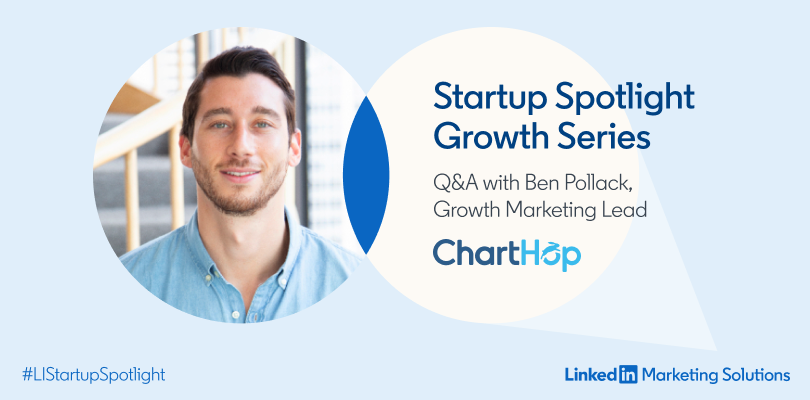ChartHop Builds a High-Quality Pipeline with the Right Product-Market Fit
LinkedIn Marketing can play an important role for B2B startups looking to scale. But what are the learnings and strategies fueling their growth? We’re excited to help answer this question with our new Growth Series: an inside look at startup marketers’ approach to successful growth. As your team builds your own marketing strategy, the perspectives shared here will help you optimize, learn, and grow faster.
In this installment of our Growth Series, we’ve interviewed ChartHop’s Growth Marketing Lead, Ben Pollack.
LinkedIn: In a sentence, tell us about ChartHop. What is a fun fact about ChartHop that we wouldn’t find on your LinkedIn Page or website?
Ben Pollack: ChartHop delivers a fresh take on People Analytics, bringing together disparate sources of people data together in a dynamic platform that’s visual and actionable.
A fun fact – we are a completely remote team distributed all over the world. An even more fun fact – we love puns and shamelessly use them for everything. Some might say we’re a hoppy bunch!
LI: What does growth mean to your team? How does your team measure growth?
Ben: Our marketing team’s core growth objective is to build high-quality pipeline that drives “hoppy” customers with the right product-market fit. We’re an ambitious venture-backed startup, so our steep new bookings targets are always balanced with a deep understanding of the customer lifecycle, shooting for best-in-class net revenue retention (at least 120%).
The secret-sauce to our growth is rapid testing, iteration, and constant cross-functional alignment across the org. And last but certainly not least, we believe that empowering personal development will drive overall team growth, so we’re always building upon our domain knowledge and skill sets.
LI: What’s something you wish you knew when first getting started with your paid growth strategy?
Ben: Growth marketers should seldom rely on paid growth as their silver bullet and not all paid spend should be directly attributable.
Paid growth is a helpful lever when accelerating lead gen and pipeline creation. With that said, much of our paid spend is focused on brand building, and that will compound over time. For me, bolstering brand awareness among our ideal customer profile (ICP) is the key objective of paid tactics, empowering more sustainable growth.
It’s also critical to set specific objectives for each channel or campaign, and set expectations accordingly internally. When strategizing your next launch, ask yourself “Is the goal of this paid spend direct lead gen? Brand building? How are we measuring this?”
LI: How did your team identify and optimize your ICP's buyer’s journey?
Ben: There are two main threads at play here: ICP identification and journey optimization.
The key to ICP identification is the first word: ideal. As a young startup with a product that can support what at times seems like infinite use-cases, it’s critical that we consistently speak with customers and analyze our full-funnel metrics (broken out by segment, channel, etc). Through this process, our goal is to truly understand the pain points we’re trying to solve and the market segments that are converting and renewing at a high rate.
Second, as a relatively new business, we have a huge opportunity to increase funnel conversion rates across the board. For us, this all truly begins first with measuring behavior, and second, testing which messages, touchpoints or tactics help facilitate improvements in conversion rate.
LI: What key adjustments have you made to your growth strategy over time and what impact did these have on results?
Ben: Focus. It’s really a relentless, continued emphasis on focus and specificity across the board. Selling into a large total addressable audience like Human Resources, it can be easy to fall into the trap of creating generalized content in an attempt to capture interest from the entire market.
In reality, it’s more effective to run hyper-specific campaigns to a small slice of your target audience to ensure that the messaging really resonates (i.e., bid on a specific use-case or keyword, create remarketing flows for that audience, build nurture cadences for those same prospects that have turned into warm leads, etc). From an impact perspective, these tactics drive immense improvements in conversion rates, spend efficiency and the overall prospect/customer experience.
LI: How do you balance your sales cycle and measuring ROI from paid marketing initiatives?
Ben: Our sales cycles vary in length depending on the size of the customer and complexity of the deal. This can make measuring paid marketing initiatives quite difficult at times – on top of the fact that marketing attribution is a challenging, and misunderstood, discipline.
In my opinion, marketing orgs should always strive to prove ROI in any way they can (direct attribution, correlated attribution, etc). Accurate ROI measurement does not come to fruition without clear goal setting based on the true objective at hand – as an example, if a paid marketing initiative is aimed at creating a category in the long run, it would be foolish to assume immediate return on ad spend.
LI: How do you achieve and measure successful alignment between sales and marketing?
Ben: From day one, we have made the sales and marketing relationship a priority at ChartHop. Sales should always feel like marketing is there to support their goals – and if sales meets their goals, we meet ours.
In many companies, the main marketing Key Performance Indicator (KPI) is Marketing Qualified Leads (MQLs) driven from inbound, which I think is fundamentally flawed – it creates a natural tension between the two departments. We quickly realized that in order to achieve full alignment, we needed to change our KPI to pipeline created (Sales Qualified Leads). With this, both teams are squarely focused on the north star goal (Annual Recurring Revenue and new bookings) and the prerequisite objective it takes to get there (pipeline)
In addition, we create structured feedback loops, looking at metrics like full funnel conversion rates broken out by different segments (all the way from lead to customer satisfaction score). From a more qualitative perspective, our sales and marketing teams are in constant communication, both on the ground floor and on the leadership levels.
Last, but perhaps most importantly, we leverage robust marketing technology and operations. Through a combination of Hubspot workflows, Outreach sequences, Clearbit data and Slack notifications, we’re able to surface prospect activity in real-time to our sales team (i.e., demo requests, content downloads, re-engagement and everything in-between). This fosters a culture of transparency and empowers our sales team to deploy highly relevant touchpoints to our prospects as quickly as possible.
LI: How does content marketing fuel your lead gen strategy?
Ben: Content marketing is at the core of our lead gen strategy, but in different ways, with varied objectives and distribution tactics.
We produce several engaging blog articles a month to build a healthy Search Engine Optimization (SEO) foundation, which in time should drive a high volume of leads at a low cost. In tandem, we grow brand awareness through thought leadership and other content that’s hyper-topical, both gated and ungated. Conversely, some of our content is aimed at creating intent, written with a more product marketing lens.
It’s critical to produce content with a distribution-focused mindset, ensuring content both resonates with and reaches the desired target audience. Our ICP is somewhat unique in that they’re often the only person in their company doing that type of work, so providing them with best-in-class content goes a long way to create and sustain brand affinity.
LI: What type of content have you seen perform well on LinkedIn?
Ben: Thought leadership through guides and e-books has historically performed well for us. Customer case studies also consistently drive high click through rates and deliver strong ROI; to no surprise, prospects are really interested in learning how their peers at other leading companies are leveraging tech to do their jobs better!
Regardless of the type of content, there needs to be a tight fit between the content being distributed and the audience it’s being distributed to. A generalized piece of content promoted to an umbrella audience won’t deliver the impact you’re hoping for.
LI: What tools or resources do you use to plan and execute your content marketing strategy?
Ben: We’re always looking for new ways to learn, which helps inform our content marketing strategy – and there’s no substitute for simply engaging with other content, customers, partners and analysts in the space. We work closely with the industry to understand the challenges they’re facing so we can provide real value in the content we’re creating.
Through those learnings and conversations, we’re able to consistently produce strong content with a unique angle, packaged in the right way with a tight focus. Execution-wise, as a growth marketer, I seriously embody a distribution-first mindset. We leverage LinkedIn’s targeting solutions plus other third party audience tools (i.e., Primer) to run hyper-targeted content distribution campaigns.
To keep pace with the latest thinking in digital marketing, subscribe to the LinkedIn Marketing Blog today.
Topics: Small business LinkedIn Ads Startups
Related articles





